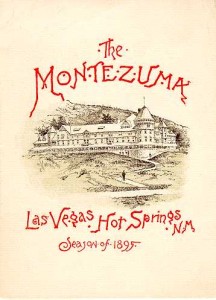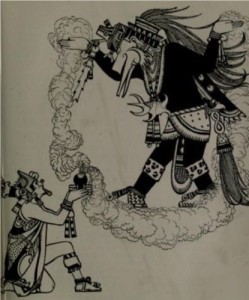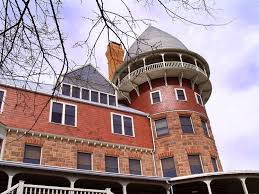On the way up to Western Life Camp are some historically significant hot springs that share the name of Montezuma with the neighboring village and, previously, with the hotel, or castle, that is now the United World College. One sleepy summer, curiosity got the better of me and I researched the mystery of the name (see references below). After a day or so in the coolness of Santa Fe’s Historical Library, viewing and taking notes from old handwritten bits and pieces of a local legend with many variations, I pieced together the legend with the parts common to most of the old stories.
 It turns out that the Montezuma Hot Springs were sacred to the people of Pecos Pueblo, one of the largest northern pueblos in its heyday. Not only was Pecos Pueblo prosperous and powerful, it controlled access to and from the Great Plains, making it a center of trade where the hunting tribes brought their hides and dried meat to trade for fruits and vegetables grown by the different pueblos. Other trade items included shells obtained from the coastal tribes and rare feathers for ceremonial use. The spiritual leaders of Pecos Pueblo kept the trading fair and had areas that were treated as sanctuary, where members of different tribes who might be in conflict could meet in peace.
It turns out that the Montezuma Hot Springs were sacred to the people of Pecos Pueblo, one of the largest northern pueblos in its heyday. Not only was Pecos Pueblo prosperous and powerful, it controlled access to and from the Great Plains, making it a center of trade where the hunting tribes brought their hides and dried meat to trade for fruits and vegetables grown by the different pueblos. Other trade items included shells obtained from the coastal tribes and rare feathers for ceremonial use. The spiritual leaders of Pecos Pueblo kept the trading fair and had areas that were treated as sanctuary, where members of different tribes who might be in conflict could meet in peace.
One such place was at Montezuma, at the sacred hot springs. Warriors guarded passage to and from the springs at all times. The strong spiritual traditions were challenged one day because a spiritual leader, a cacique, was near death but had no apprentice to take his place. This could mean the loss of sacred knowledge and traditions, threatening the stability of the people. Death came all too quickly and the people drew lots to select the new cacique. The lot fell to a young man of 13 summers to lead his people. Now this young man had already begun having visions and had begun to feel the call of the medicine path. In his visions, the Thunderbird flew, leading him and his people to a new land and signifying the end of the journey by alighting on a cactus and drawing up a serpent in its beak. The people heard the vision of the new cacique and accepted his spiritual leadership. Where he led, they began following him south as he, in turn, followed the path of the Thunderbird. When the Thunderbird would alight, the people would stop to settle, gather food and hunt to replenish their supplies. From time to time, they stopped at pueblos along the way, where the local people heard the vision and joined the throng to follow the cacique who followed the Thunderbird. It has often been reported that many of the southern pueblos look as if they were instantly abandoned, as if the inhabitants rose from their midday meal and left as one. This was indeed the case as, upon catching the vision of the young and charismatic cacique, they felt the call to follow. Long months passed as the people would be certain that they were at last at their destination as, time after time, the Thunderbird would land on a cactus. The cacique would solemnly remind them that the second half of the vision had yet to be fulfilled and they must continue their migration path until the vision was complete.
 Finally, one day when the people had all but given up that the vision would be fulfilled in their lifetimes, the second half of the vision was fulfilled. They had been following the cacique who followed the Thunderbird through village after village, growing more and more numerous as each group of inhabitants rose as one and followed. The cacique called a halt and gathered the people to hear the good news, that both halves of the vision had been fulfilled. The Thunderbird had come to rest at last, alighting upon the cactus as he had so many times before but this time he had taken the serpent in his beak. Rejoicing was great as the people knew they were where they were meant to be. They remained to found a people, a dynasty and a country for the name of the city they built was Mexico City and the name of the young cacique was Montezuma.
Finally, one day when the people had all but given up that the vision would be fulfilled in their lifetimes, the second half of the vision was fulfilled. They had been following the cacique who followed the Thunderbird through village after village, growing more and more numerous as each group of inhabitants rose as one and followed. The cacique called a halt and gathered the people to hear the good news, that both halves of the vision had been fulfilled. The Thunderbird had come to rest at last, alighting upon the cactus as he had so many times before but this time he had taken the serpent in his beak. Rejoicing was great as the people knew they were where they were meant to be. They remained to found a people, a dynasty and a country for the name of the city they built was Mexico City and the name of the young cacique was Montezuma.


Mary Kay – Thank you for this most interesting blog post! Keep up the good work.
Mary Kay, such a perfect first blog for the Campground! I know Uncle Mel is smiling and popping buttons from pride! I remember putting my feet in the hot spring off the side of the road with him just a few short years ago. We had great conversation and pure relaxation that beautiful sunny afternoon. Now I had some “history” to add to that wonderful time with him. I look forward to many more of your blogs, Cuz!! Great job!!